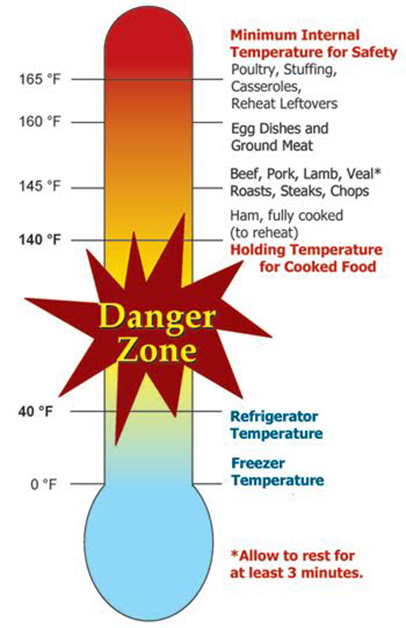“Last night, I left cooked roast beef on the counter to cool before refrigerating, but I fell asleep and discovered it this morning. I immediately put it in the refrigerator. Since the meat is cooked, shouldn’t it be safe to eat?”
The U.S. Department of Agriculture’s toll-free Meat and Poultry Hotline at 888-674-6854 receives similar calls daily from consumers who are confused about how to keep their food safe. The answer to this caller’s question is that the roast beef should be thrown out. Why? Because leaving food out too long at room temperature can cause bacteria (such as Staphylococcus aureus, Salmonella Enteritidis, E. coli O157:H7, and Campylobacter) to grow to dangerous levels that can cause illness.
Bacteria exist everywhere in nature. They are in the soil, air, water, and food. When bacteria have nutrients (food), moisture, time, and favorable temperatures, they multiply, increasing to the point where some can cause illness. Understanding the vital role temperature plays in keeping food safe is critical. Knowing the temperature at which food has been handled, we can answer the question, “Is it safe?”

The “Danger Zone” (40 degrees F to 140 degrees F)
Bacteria grow most rapidly in temperatures between 40 degrees F and 140 degrees F, doubling in number in as little as 20 minutes. This range of temperatures is often called the “Danger Zone.” That’s why the Meat and Poultry Hotline advises consumers to never leave food out of refrigeration over 2 hours. If the temperature is above 90 degrees F, food should not be left out for more than 1 hour.
If you are traveling with cold food, take a cooler with plenty of ice, frozen gel packs, or another cold source. If you are cooking, use a hot campfire or portable stove. It is difficult to keep foods hot without a heat source when traveling, so it’s best to cook foods before leaving home, cool them, and transport them cold.
Cooking
Raw meat and poultry should always be cooked to a safe minimum internal temperature. When roasting meat and poultry, use an oven temperature no lower than 325 degrees F. Use a food thermometer to ensure that meat and poultry have reached a safe minimum internal temperature.
- Cook all raw beef, pork, lamb, and veal steaks, chops, and roasts to a minimum internal temperature of 145 degrees F as measured with a food thermometer before removing meat from the heat source. For safety and quality, allow meat to rest for at least three minutes before carving or consuming. For reasons of personal preference, consumers may choose to cook meat to higher temperatures.
- Cook all raw ground beef, pork, lamb, and veal to an internal temperature of 160 degrees F as measured with a food thermometer.
- Cook all poultry to a safe minimum internal temperature of 165 degrees F as measured with a food thermometer.
If raw meat and poultry have been handled safely, the above preparation recommendations will make them safe to eat. If raw meats have been mishandled, left in the “Danger Zone” too long, bacteria can grow and produce toxins that can cause foodborne illness. Those toxins that are heat resistant are not destroyed by cooking. Therefore, even though cooked, meat and poultry mishandled in the raw state may not be safe to eat even after proper preparation.
Storing Leftovers
One of the most common causes of foodborne illness is improper cooling of cooked foods. Because bacteria are everywhere, even after food is cooked to a safe internal temperature, they can be reintroduced to the food and then reproduce. For this reason, leftovers must be put in shallow containers for quick cooling and refrigerated within 2 hours.
Reheating
Foods should be reheated thoroughly to an internal temperature of 165 degrees F or until hot and steaming. In the microwave oven, cover the food and rotate it so it heats evenly. Follow the manufacturer’s instructions for stand time for more thorough heating. Without the manufacturer’s instructions, at least a two-minute stand time should be allowed.
Cold Storage Temperatures
Properly handled food stored in a freezer at zero degrees F will be safe. Freezing keeps food safe by slowing the movement of molecules, causing bacteria to enter a dormant stage. Once thawed, these bacteria can become active and multiply to levels that may lead to foodborne illness. Because bacteria on these foods will grow at about the same rate as they would on fresh food, thawed foods should be handled as any other perishable food.
A temperature of 40 degrees F or lower should be maintained in the refrigerator. In contrast to freezer storage, perishable foods will gradually spoil in the refrigerator. Spoilage bacteria will make themselves known in a variety of ways. The food may develop an uncharacteristic odor color or become sticky or slimy. Molds may also grow and become visible. However, many times contaminated foods may not look, smell or taste spoiled. Bacteria capable of causing foodborne illness either don’t produce or grow very slowly at refrigerator temperatures. An appliance thermometer should always be used to verify that the unit’s temperature is correct.
Safe food-handling practices are a good defense against foodborne illness. Because we know how different temperatures affect the growth of bacteria in our food, we can protect ourselves and our families from foodborne illnesses by adequately handling, cooking, and storing foods at safe temperatures.
(To sign up for a free subscription to Food Safety News, click here.)
